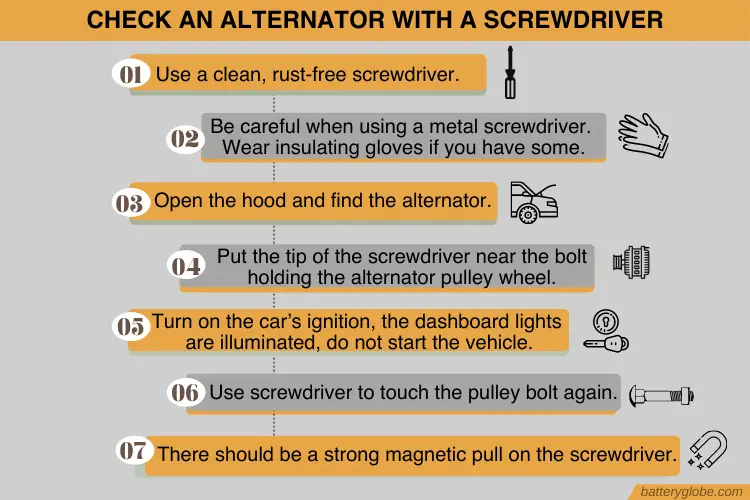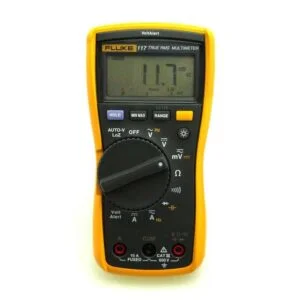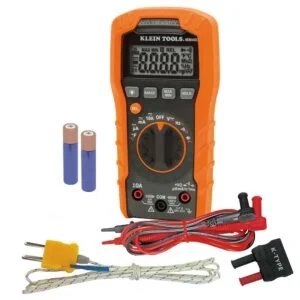The alternator is a fundamental piece of the electrical system on your vehicle. Without it, your battery will very quickly run out of charge, and your car won’t start.
Testing your alternator with the battery disconnected is not a safe method, and may damage your vehicle. In this brief article, we show you how to safely test your car alternator.
Is It Safe To Test Alternator By Disconnecting The Battery?
No, it is not safe to test your alternator with the battery disconnected. In the past, forty or fifty years ago, it was acceptable to test your alternator this way. However, there are now two good reasons we don’t recommend this:
Reason #1
With the battery disconnected, the car’s charging circuit will detect a flat battery with zero charges. This, in turn, will cause the alternator to work at full capacity trying to charge the battery.
Your alternator is not designed to produce this much current for long periods. It will generate excess, damaging heat, shortening your alternator’s life.
Reason #2
Your alternator is part of an electrical system, including the battery and regulator. The battery acts as a buffer, reducing voltage spikes.
With it disconnected, the alternator can produce 150-volt spikes, possibly damaging sensitive electronic equipment.
Test An Alternator With A Multimeter
Step-by-step guide to test your alternator with a multimeter

- Make sure your battery is fully charged. Use a modern trickle charger to ensure your battery is in the best condition possible.
- With the engine off, connect a multimeter to the battery terminals. Black to black, and red to red.
- Make sure all the accessories in your car are switched off. This includes the radio, lights, air conditioning – everything.
- Check the voltage. It should be around 12.6 volts.
- Start the engine and recheck the voltage. It should read between 14.2 and 14.7 volts.
- Now switch on all your car’s electrical accessories, such as the radio and lights. Recheck the voltage. It should not drop below 13 volts. If it does, the battery is not getting enough charge from the alternator.
- Switch off your accessories and then the engine. Check the voltage, and it should be around 13 volts. This indicates that the alternator has been charging the battery.
Find purchasing options for the best Multimeter to test your alternator online:

Fluke 117 Electricians True RMS Multimeter

Klein Tools MM400 Digital Multimeter
What Should I Do After Doing The Test?

- The most basic check is to make sure the battery terminals are clean. Dirt and corrosion on the terminals will prevent proper charging. You can clean them with wire wool or sandpaper.
- Also, check the grounding terminal, where the battery negative terminal connects to the car. A poor ground will also cause issues.
- Check all the cables and connectors around the alternator and battery.
- For an alternator that stops working suddenly, the brushes may be worn out. These are relatively easy to replace, but if you’re not sure, take the alternator to a mechanic.
- It is possible to test the alternator output using an oscilloscope, but not many people can access these.
Test An Alternator’s Function With A “Full-field” Test
The only way to test an alternator properly is to force it to work at its full output. This is called the full-field test. The regulator limits the alternator’s output in routine operation, protecting the battery and car’s electronics.
You should only do this test very briefly to ensure no damage occurs.
Each vehicle is different, but the basic test involves connecting the alternator’s field terminal to the ground. When you do this, you are bypassing the regulator, and the alternator produces maximum voltage.
Other types of alternators require the field terminal to be connected to the positive terminal of the battery. It is crucial to make sure you find out which type of alternator you have.
Whichever type of alternator you have, the aim is to ensure that the alternator produces a large voltage increase when full-fielded. If it does, then there may be a problem with your regulator.
How Can I Test My Alternator Without Multimeter?
Check An Alternator With A Screwdriver (Alternator Magnetic Test)
- Use a clean, rust-free screwdriver. Any rust could cause a false result.
- Be careful since we are using a metal screwdriver around electrical systems. Wear insulating gloves if you have some.
- Open the hood and find the alternator.
- Put the tip of the screwdriver near the bolt holding the alternator pulley wheel. Nothing should happen.
- Turn on the car’s ignition, so the dashboard lights are illuminated, but do not start the vehicle.
- Use the screwdriver to touch the pulley bolt again.
- This time, there should be a strong magnetic pull on the screwdriver, even from quite a distance away.
If you didn’t feel the strong magnetic pull, either the alternator or the regulator is faulty.
Take Your Battery And Alternator To An Auto Parts Store
Some auto parts stores offer a free checking service, such as AutoZone or O’Reilly’s. You will normally have to remove the alternator and battery and take them into the store for a full free check.
How does AutoZone (Auto Parts Store) test your alternator?
Auto zone bench test your alternator using a purpose-built test rig. The test rig will load test your alternator to ensure that it gives sufficient voltage output.
Does AutoZone give you money for an old alternator?
Yes, AutoZone offers a refund of what is called your “core deposit” if you bring the old item in for replacement. This is currently around $40, so definitely worth having.
How accurate is the AutoZone alternator test?
The AutoZone test will accurately test the output of your alternator on that day. That is not to say that in six months, the alternator won’t fail.
The internal parts at the time of the test may have just been at the point of degrading. But they gave good results on the day of the test.
FAQs
1. What does a bad alternator sound like?
If there is a rumbling, grinding noise, then it’s a sure sign the bearings have failed. On the other hand, if you hear a whining noise, it may be the regulator that has failed.
2. What causes the alternator to fail?
The most common failure is old age. A typical alternator will last between 5 and 8 years before starting to show signs of wear. A bad battery can also speed up the failure of your alternator.
Batteries that are failing will demand more of a charging current from the alternator. It’s not designed for this, and the excess heat generated can lead to the alternator failing.
3. Is it expensive to fix an alternator?
The price of an alternator varies greatly between vehicles. Smaller alternators may cost you around $100, whereas a large, powerful alternator may be several hundred dollars.
Replacement cost is also variable, as, on some vehicles, it’s an easy swap. Unfortunately, it can be difficult on other cars and may require additional parts to remove for access.
Overall, expect to pay upwards of $150/ $200 on an average car.
4. How to test alternator with a test light?
An easy way of spotting potential problems with an alternator is by looking at your internal lights. When an alternator starts to fail, you may see the interior lights or your dashboard lights flickering. This is a definite indication of a fault in the electrical charging circuit and needs to be investigated.
Conclusion
Your alternator is a vital component of your car. Without it, your battery will go flat, and your car won’t start. Luckily, there are some easy ways to test your alternator with the battery connected still.
Hopefully, this short guide on testing your alternator has helped you diagnose a problem and get back on the road.
